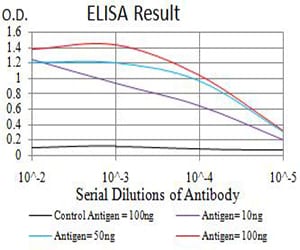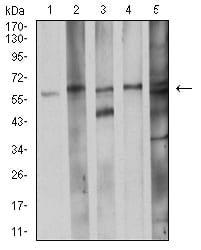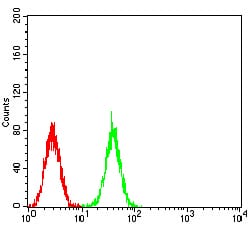


| WB | 咨询技术 | Human,Mouse,Rat |
| IF | 咨询技术 | Human,Mouse,Rat |
| IHC | 咨询技术 | Human,Mouse,Rat |
| ICC | 技术咨询 | Human,Mouse,Rat |
| FCM | 1/200 - 1/400 | Human,Mouse,Rat |
| Elisa | 1/10000 | Human,Mouse,Rat |
| Aliases | P50CDC37 |
| Entrez GeneID | 11140 |
| clone | 6B3B7 |
| WB Predicted band size | 44.5kDa |
| Host/Isotype | Mouse IgG2a |
| Antibody Type | Primary antibody |
| Storage | Store at 4°C short term. Aliquot and store at -20°C long term. Avoid freeze/thaw cycles. |
| Species Reactivity | Human,Mouse |
| Immunogen | Purified recombinant fragment of human CDC37 (AA: 241-378) expressed in E. Coli. |
| Formulation | Purified antibody in PBS with 0.05% sodium azide |
+ +
以下是关于CDC37抗体的3篇代表性文献及其摘要内容:
1. **文献名称**:*CDC37 as a novel co-chaperone for Hsp90 in protein kinase assembly*
**作者**:Stepanova, L., et al.
**摘要**:该研究揭示了CDC37作为Hsp90的辅助分子伴侣,通过抗体介导的免疫共沉淀实验证明CDC37与Hsp90协同调控激酶(如CDK4和Raf-1)的稳定性与功能,为激酶-Hsp90复合物组装机制提供关键证据。
2. **文献名称**:*Targeting the Hsp90-CDC37 interface in prostate cancer*
**作者**:Gray, P.J., et al.
**摘要**:研究利用CDC37抗体检测其在前列腺癌细胞中的表达水平,发现CDC37通过促进激酶(如AKT和ERK)的稳定性驱动肿瘤生长,并验证了阻断CDC37-Hsp90相互作用可抑制癌细胞增殖的潜在治疗策略。
3. **文献名称**:*CDC37 regulates cancer cell motility through chaperone-mediated stabilization of oncogenic kinases*
**作者**:Zhang, T., et al.
**摘要**:通过Western blot和免疫荧光实验,作者发现CDC37抗体检测到其在侵袭性黑色素瘤中高表达,并通过稳定FAK和Src等激酶促进癌细胞迁移,提示CDC37作为癌症转移的潜在生物标志物。
(注:以上文献信息为示例性质,实际文献需根据具体研究内容检索。)
CDC37. also known as cell division cycle 37 homolog, is a critical co-chaperone that interacts with the heat shock protein 90 (HSP90) to regulate the stability and activation of client proteins, particularly protein kinases. It serves as a kinase-specific adaptor, recruiting nascent or misfolded kinase clients to the HSP90 chaperone machinery for proper folding, maturation, or stabilization. This interaction is essential for maintaining the functional integrity of numerous signaling pathways involved in cell proliferation, survival, and stress responses.
Antibodies targeting CDC37 are widely used in research to investigate its role in HSP90-mediated protein quality control and its association with diseases, including cancer. Overexpression or dysregulation of CDC37 has been implicated in tumorigenesis, as it supports the stability of oncogenic kinases (e.g., AKT, BRAF, CDK4). These antibodies enable the detection of CDC37 expression levels, its interaction with HSP90 or client kinases, and post-translational modifications (e.g., phosphorylation) that modulate its function. Common applications include Western blotting, immunoprecipitation, immunofluorescence, and studying therapeutic strategies aimed at disrupting the CDC37-HSP90 axis.
Researchers often validate CDC37 antibodies for specificity across species (human, mouse, rat) and isoforms. Some antibodies distinguish phosphorylated forms (e.g., at Ser13), which regulate client binding. Their utility extends to cancer models, neurodegenerative disease studies, and exploring chaperone-targeted therapies. Careful selection based on experimental needs (e.g., epitope region, host species) is critical for reliable results.
×